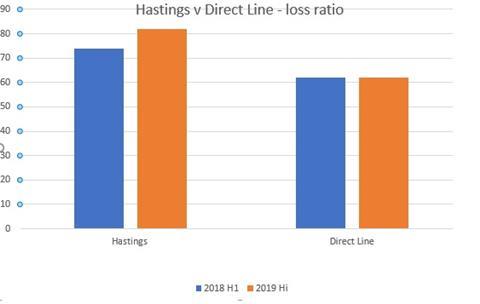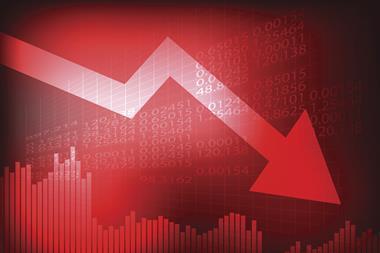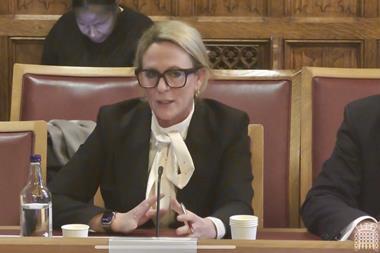Hastings shares fell last week as it announced its H1 financial results
For Blouson_blouse , one of the many Hastings retail investors, the company was a revelation.
Speaking in an online discussion forum, Blouson_blouse claimed to have snapped up shares at 168p upon the Hastings stock market launch in October 2015.
“Great company. I bought in about 6 months ago with confidence on a 3-year basis but never expected to be sitting on an almost 50% gain so quickly,” the colourfully-named Hastings supporter wrote.
Blouson_blouse wasn’t the only one excited.
At the start of last year, analysts and market watchers believed Hastings could be the new Admiral, the Cardiff-based motor insurer rival that had delivered stellar stock market returns since floating in 2004.
What happened next has surprised nearly everyone.
Hastings shares have been on an 18-month downturn, falling 40% in that time.
From an all-time high of 320p, the shares are now worth 190p.
What’s happened? When will Hastings come out of this slide?
These are the questions being asked by analysts and investors.
Claims inflation struggles
Hastings has made a series of announcements that have dented investor confidence.
It began last year when it revealed reduced growth expectations.
Then at half-year 2018, Hastings gave guidance that claims inflation would be worse than what the market expected.
The problems continued into 2019, with the share price sliding further.
In February, Hastings said loss ratio would be at the higher end of the 75% – 79% target range.
Then last week, Hastings said its loss ratio for the half year, excluding the impact of Ogden, was 79.1%.
The problem is that claims inflation is running at between 6% and 7%, well ahead of any increases in premiums.
Hastings partly blames the claims costs of fixing computerised cars that have expensive imported parts, which are even more costly as the pound has plunged on Brexit worries.
However, other rivals have been better at controlling their loss ratios. Direct Line’s loss ratio was 60.9% this time last year and stands at 61.9% today.

Hastings’ loss ratio worsened from 73.8% to 79.1% in the last year, excluding the impact of Ogden.
The difference with Direct Line is that Hastings’ business mix is heavily reliant on vehicles, with a tiny proportion - less than 1% - coming from home insurance.
Direct Line has around a third of its underwritten business coming from home and SME, meaning although its motor loss ratio deteriorated in a similar way to Hastings, this was balanced out by a benign weather year on home and SME leading to the much better overall company loss ratio.
The result is that at the half-year Direct Line posted a superior combined ratio - 2.3% better at 94.6%.
So even with its cheaper cost base, Hastings is now posting a worse combined ratio than Direct Line.
Others believe Hastings was always going to have growing pains because it had grown so quickly.
After cutting its earnings estimates, RBC Capital Markets analysts said Hastings had been “one of the faster-growing motor insurance companies in the UK in the last four years” despite operating within a “challenging market”.
Fixing the problems
Hastings is trying to do the right things to solve the problem. It has tightened up its pricing, cut the number of young drivers on its book and is poring over its vast volumes of data to target less risky segments.
This has led some to believe that Hastings will eventually reap the rewards.
Hastings analyst Iain Pearce said: “Will this be the last earnings downgrade in this cycle for Hastings?
“This is the key question for investors. In our view, the answer to the question will depend on the pricing environment in the second half of the year.”
Numis Securities said: “We expect the shares to remain subdued until there is evidence margins are improving. On the plus side, it is notable that Hastings has sufficient confidence in its business to continue customer growth.”
Hastings chief financial officer John Worth, speaking to Insurance Times after the results, said work has been done to keep pricing abreast of claims inflation.
The second half of this year was likely to show improved performance.
“We have seen this gap widen between the rate of which we can increase our prices to match the cost of claims,” Worth said.
“What we [now] are seeing is this gap narrowing during the first half of this year, which is really a sign of the market turning.
“We have been able to apply rate increases and those increases have stuck. We are also seeing that amongst our competitors as well.
“What we should see, going into the second half of this year, is the gap between premium inflation and claims inflation closing so that should feed through in terms of a better operating result going forward.”
Berenberg’s Pearce agrees that the market has to turn.
“Industry profitability is reaching breaking point, claims inflation drivers look set to continue, reserving buffers are reducing and the lower-than-expected Ogden rate adds to the inflationary environment. If such an environment materialises, we would expect Hastings to be the major beneficiary,” he says.
It may be that the market will turn and Hastings will climb back to its former glory.
Blouson_blouse and his retail investor friends will certainly be hoping so.
Passnotes - Hastings

What are the origins of Hastings?
Hastings Direct was started up in 1997. It was eventually taken over by Insurance Australia Group (IAG) in 2006. However, IAG’s UK business got burned up badly by the claims and whiplash storm ten years ago. It had to bail out its Lloyd’s Equity business after a catastrophic foray onto price comparison sites.
Eventually it decided to sell up its UK companies, including Hastings. Ex-IAG UK boss Neil Utley (pictured) saw a great opportunity and moved in. With first private investor money and then private equity cash from Goldman Sachs, he turned it around into a slick firm purpose-built for aggregators. Utley is now one of the richest men in Britain, with enough spare cash to snap up David Beckham’s old home.
Has it been a success?
Hastings has been a success story. It was a small time motor broker 20 years ago, but in the next few years it will hit three million customers. An incredible achievement.
So what is the concern lately?
Hastings shares have been on a slide for the last 18 months and now aren’t worth that much more than when they first floated on the stock market. This will be a disappointment to shareholders who were hoping it would be both a growth and income stock, like Admiral.
Hastings is struggling to control the claims inflation but there is confidence the business will pick up once rates rise, as they likely will after such a period of sustained pressure and the latest Ogden disappointment.
Hosted by comedian and actor Tom Allen, 34 Gold, 23 Silver and 22 Bronze awards were handed out across an amazing 34 categories recognising brilliance and innovation right across the breadth of UK general insurance.






















































No comments yet